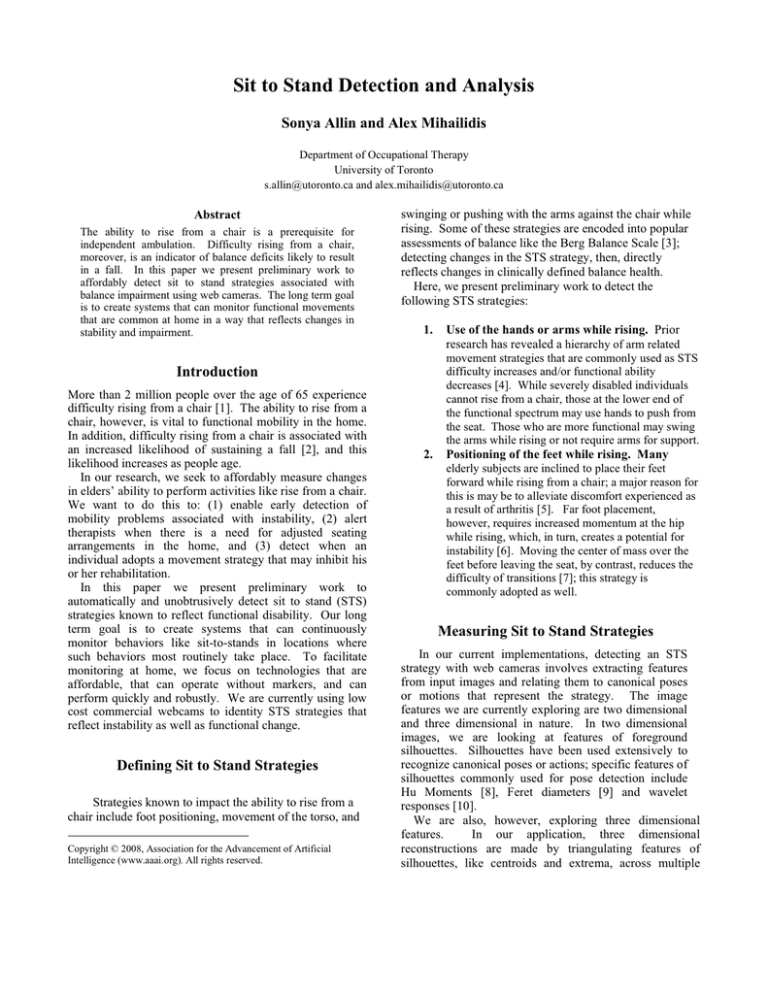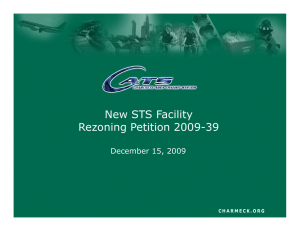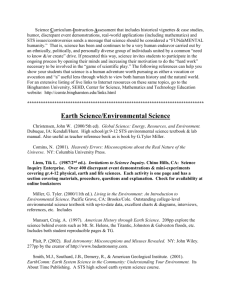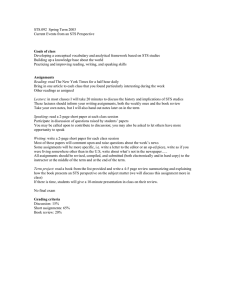
Sit to Stand Detection and Analysis
Sonya Allin and Alex Mihailidis
Department of Occupational Therapy
University of Toronto
s.allin@utoronto.ca and alex.mihailidis@utoronto.ca
Abstract
The ability to rise from a chair is a prerequisite for
independent ambulation. Difficulty rising from a chair,
moreover, is an indicator of balance deficits likely to result
in a fall. In this paper we present preliminary work to
affordably detect sit to stand strategies associated with
balance impairment using web cameras. The long term goal
is to create systems that can monitor functional movements
that are common at home in a way that reflects changes in
stability and impairment.
swinging or pushing with the arms against the chair while
rising. Some of these strategies are encoded into popular
assessments of balance like the Berg Balance Scale [3];
detecting changes in the STS strategy, then, directly
reflects changes in clinically defined balance health.
Here, we present preliminary work to detect the
following STS strategies:
1.
Introduction
More than 2 million people over the age of 65 experience
difficulty rising from a chair [1]. The ability to rise from a
chair, however, is vital to functional mobility in the home.
In addition, difficulty rising from a chair is associated with
an increased likelihood of sustaining a fall [2], and this
likelihood increases as people age.
In our research, we seek to affordably measure changes
in elders’ ability to perform activities like rise from a chair.
We want to do this to: (1) enable early detection of
mobility problems associated with instability, (2) alert
therapists when there is a need for adjusted seating
arrangements in the home, and (3) detect when an
individual adopts a movement strategy that may inhibit his
or her rehabilitation.
In this paper we present preliminary work to
automatically and unobtrusively detect sit to stand (STS)
strategies known to reflect functional disability. Our long
term goal is to create systems that can continuously
monitor behaviors like sit-to-stands in locations where
such behaviors most routinely take place. To facilitate
monitoring at home, we focus on technologies that are
affordable, that can operate without markers, and can
perform quickly and robustly. We are currently using low
cost commercial webcams to identity STS strategies that
reflect instability as well as functional change.
Defining Sit to Stand Strategies
Strategies known to impact the ability to rise from a
chair include foot positioning, movement of the torso, and
Copyright © 2008, Association for the Advancement of Artificial
Intelligence (www.aaai.org). All rights reserved.
2.
Use of the hands or arms while rising. Prior
research has revealed a hierarchy of arm related
movement strategies that are commonly used as STS
difficulty increases and/or functional ability
decreases [4]. While severely disabled individuals
cannot rise from a chair, those at the lower end of
the functional spectrum may use hands to push from
the seat. Those who are more functional may swing
the arms while rising or not require arms for support.
Positioning of the feet while rising. Many
elderly subjects are inclined to place their feet
forward while rising from a chair; a major reason for
this is may be to alleviate discomfort experienced as
a result of arthritis [5]. Far foot placement,
however, requires increased momentum at the hip
while rising, which, in turn, creates a potential for
instability [6]. Moving the center of mass over the
feet before leaving the seat, by contrast, reduces the
difficulty of transitions [7]; this strategy is
commonly adopted as well.
Measuring Sit to Stand Strategies
In our current implementations, detecting an STS
strategy with web cameras involves extracting features
from input images and relating them to canonical poses
or motions that represent the strategy. The image
features we are currently exploring are two dimensional
and three dimensional in nature. In two dimensional
images, we are looking at features of foreground
silhouettes. Silhouettes have been used extensively to
recognize canonical poses or actions; specific features of
silhouettes commonly used for pose detection include
Hu Moments [8], Feret diameters [9] and wavelet
responses [10].
We are also, however, exploring three dimensional
features.
In our application, three dimensional
reconstructions are made by triangulating features of
silhouettes, like centroids and extrema, across multiple
synchronized camera views. Similar blob based stereo
reconstructions have been used for sign language
recognition [11] and gesture recognition in interactive
games [12]. Three dimensional reconstructions have an
advantage over 2D ones in that they more directly relate to
kinematic and dynamic analyses of STS stability, like [6].
the cameras. The two chairs were located two feet from
one another and were oriented to form a 90 degree angle
between them. Two chairs were used to test the ability of
the system to detect sit to stands and STS strategies at
various orientations and locations with respect to the
cameras.
Using Web Cameras to Predict Strategies
Figure 1. STS recognition system. Three calibrated Logitech webcams
are used to capture synchronized video of individuals as they rise from a
chair. At the top are input images from all cameras; at the bottom are
extracted silhouettes annotated with 2D estimates of the head, feet and
torso locations. 2D features are triangulated across views to create 3D
reconstructions of the torso and lower body. An example reconstruction
is shown at the far right; this reconstruction has been back projected on
top of a silhouette from one view.
Our system includes three Logitech web cameras that
record at a rate of 30 frames per second and are
synchronized by means of a DirectShow filter. Video is
encoded in MPEG4 format, at a resolution of 340 x 280
pixels, and is transferred to a laptop via USB.
To compute two and three dimensional image features,
we first extract silhouettes of people from two dimensional
views by means of foreground segmentation. From these
two dimensional silhouettes, Hu moments [7] are
computed, as these are shape descriptors that are robust to
changes in scale and translation.
To create three dimensional reconstructions, we
triangulate silhouette centroids across all camera views.
This creates a single three dimensional point corresponding
loosely to the position of a tracked individual’s torso. We
also triangulate points on contours of silhouettes that are
maximally distant from centroids to estimate head and foot
positions. Finally, we smooth estimates of all 3D positions
with a Kalman filter. This is illustrated in Figure 1.
Methods
To determine the utility of two and three dimensional
measurements made with web cameras, we performed a
pilot experiment; in this experiment image statistics were
related to various compensatory STS strategies.
Two healthy individuals were asked to sit and stand
repeatedly from a pair of chairs while being recorded with
Figure 2. Estimated torso flexion (in degrees) during sit to stand
transitions. At the top is estimated flexion when a subject rises
repeatedly using his or her arms. In the middle is flexion when no arms
are used and at the bottom is flexion when arms are swung. The time of
all transitions have been normalized so they span 100 samples each.
Each trial required subjects to sit first on one chair, then
the other. Each time a subject sat on a chair, however, he
or she was asked to use one of a set of eight possible STS
strategies defined by use of the arms or placement of the
feet. Recorded arm strategies were as follows:
(1) no use of the arms while rising;
(2) use of the arms to push from the seat;
(3) swinging of the arms to generate momentum.
Foot strategies, by contrast, were as follows:
(1) with knees “normally” extended, at 90° angles;
(2) with knees under-extended, at 80° angles;
(3) with knees over-extended, at 100° angles.
All combinations of hand and arm positions were
recorded save for the combination involving over-extended
knees and no arm use; this was difficult to perform, even
for young subjects. Three instances of each strategy were
recorded and the order was randomized, yielding a total of
24 trails (and 48 STS actions) per subject.
Based the data, classifiers were designed to create robust
mappings between image statistics recorded at each frame
and phases of sit-to-stands (i.e. sitting, transitioning, or
standing). In addition, images statistics measured at each
frame during hand segmented STS transitions were
mapped onto the eight STS strategies. Image statistics
used to form mappings included 7 Hu moments and the
following 3D features: distances between the torso, head
and feet; distances between the torso, head and floor; the
angle created by the head, torso and feet; the speed of the
head; the angular speed of the torso; and the raw positions
of the feet. Examples of recorded “torso angles” (i.e.
angles between head, torso and feet) are shown in Figure 2.
The classification algorithm used was a J48 decision
tree, which is an extension of the classic C4.5 algorithm of
Quinlan [13] and has been built into the Weka Machine
Learning Toolkit [14]. To build the decision tree, input
video data was first hand labeled to indicate STS phases
(i.e. when subjects were sitting in the chair, when they
were transitioning to stand and when they had risen). In
addition, data recorded during STS transitions was labeled
to identify which STS strategy was used.
Using 10 fold cross validation (90% training, 10%
testing each time), the ability of image statistics to predict
phases and sit to stand strategies at every frame was tested.
We present results from one classifier built for both
subjects, although reasonable results were obtained by
training classifiers with one subject and testing on the
other. Preliminary results are found below:
Table 1. Results using 2D features alone, from 1 view
110 degrees
90 degrees
80 degrees
Foot Posn
80 degrees
1367
434
112
90 degrees
509
1060
197
110 degrees 189
291
707
Total accuracy: 64%
Push seat
Swing arms
Arm Usage No arms
No arms
784
296
223
Push seat
250
1321
248
Swing arms
221
340
1183
Total accuracy: 67%
Sitting
Transitioning Upright
STS Phase
Sitting
8331
472
976
Transitioning 337
7440
369
Upright
1488
775
2603
Total accuracy: 81%
Table 2. Results using 3D features
110 degrees
90 degrees
80 degrees
Foot Posn
80 degrees
1817
79
17
90 degrees
89
1646
31
110 degrees 16
36
1135
Total accuracy: 94%
Push seat
Swing arms
Arm Usage No arms
No arms
1136
100
67
Push seat
92
1636
91
Swing arms
79
95
1570
Total accuracy: 89%
Sitting
Transitioning Upright
STS Phase
Sitting
9258
222
299
Transitioning 196
7626
324
Upright
360
388
4118
Total accuracy: 92%
Conclusion
We have presented preliminary data indicating that 2D
features from silhouettes can reasonably be used to detect
STS phases (i.e. Sits, Transitions, Stands) that take place at
multiple orientations; coarse 3D reconstructions, moreover,
predict STS strategies associated with disability. We
expect results can improve significantly with temporal
smoothing of classifications. Admittedly, results are
limited as they relate to a small number of healthy
individuals who are similar in size. In the future, we
expect to deploy functional monitoring devices in the
homes of elders to look for changes in behaviors, like sit to
stands, which reflect instability or have the potential to
adversely impact rehabilitation outcomes.
References
1. Dawson D, Hendershot G, Fulton J, 1987. Aging in the Eighties.
Functional Limitations of Individuals Age 65 and Over. National Center
for Health Statistics: Advance Data from Vital and Health Statistics,
DHHS (PHS) 133: 87-1250.
2. Topper AK, Maki BE, Holliday PJ. 1993. Are activity-based
assessments of balance and gait in the elderly predictive of risk of falling
and/or type of fall? J Am Geriatr Soc 41: 479–87.
3. Berg K, Wood-Dauphinee S, Williams JI, Maki, B. 1992. Measuring
balance in the elderly: Validation of an instrument. Can. J. Pub. Health
2:S7-11 .
4. Mazzà C, Benvenuti F, Bimbi C and Stanhope, S. 2004. Association
Between Subject Functional Status, Seat Height, and Movement Strategy
in Sit-to-Stand Performance. J Am Geriatr Soc 52(10): 1750-1754.
5. Pai, YC., Chang, H. J., Sinacore, J. M., Chang, R. W., Lewis, JL. 1994.
Alteration in multijoint dynamics in patients with bilateral knee
osteoarthritis. Arth & Rheum 37: 1297-1304.
6. Patton, JL., Lee, W. A., Pai, Y. C. 2000. Relative stability improves
with experience in a dynamic standing task. Exp Brain Res, 135: 117-26.
7. Kawagoe, S, Tajima, N and Chosa, E. 2000. Biomechanical analysis of
effects of foot placement with varying chair height on the motion of
standing up. Journal of Orthopaedic Science 5(2): 124-133.
8. Hu, M. 1962. Visual pattern recognition by moment invariants. IEEE
Trans Info Theory 8: 179–187.
9. Lee, T. and Mihailidis, A. 2005. An intelligent emergency response
system: preliminary development and testing of automated fall detection.
J Telemedicine and Telecare, 11:194-198.
10. Ren L, Sharknarovich G, Hodgins J, Pfister, H and Viola P. 2005.
Learning Silhouette Features for Control of Human Motion, ACM
Transactions on Graphics.
11. Starner, T. Visual Recognition of American Sign Language Using
Hidden Markov Models. 1995. Automatic Face and Gesture Recognition.
12. Wren, C., Clarkson, B., Pentland, A. 2000. Understanding Purposeful
Human Motion. Automatic Face and Gesture Recognition.
13. Quinlan, J. 1996. Improved use of continuous attributes in c4.5. J of
Art Intel Res, 4:77-90.
14. Witten, I and Frank, E. 2005. Data Mining: Practical machine
learning tools and techniques, 2nd Ed, Morgan Kaufmann, SF
15. Talis VL, Grishin AA, Solopova IA, Oskanyan TL, Belenky VE,
Ivanenko YP. 2008. Asymmetric leg loading during sit-to-stand, walking
and quiet standing in patients after unilateral total hip replacement
surgery. Clin Biomech 23(4):424-33.






